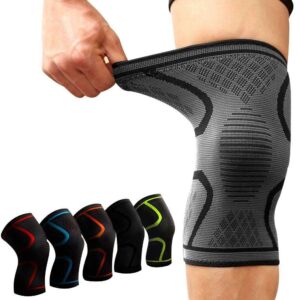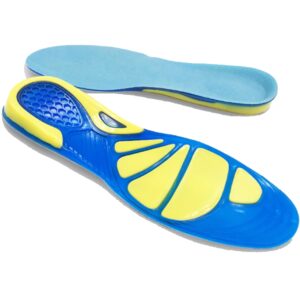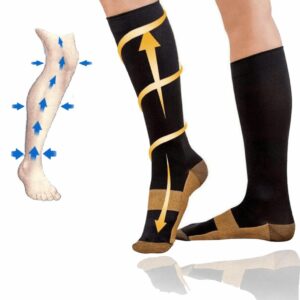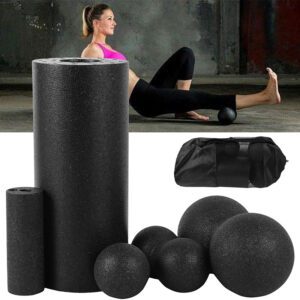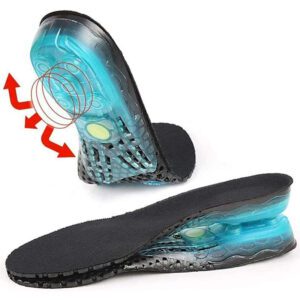Plantar fasciitis is one of the most common causes of foot pain. It can be a difficult condition to manage and symptoms can range from mild to severe. Fortunately, there are a variety of treatments available to help relieve the discomfort, including foam rolling exercises.
Foam rollers have been gaining popularity as an easy and effective way to reduce tension in muscles and connective tissue. This type of exercise helps increase circulation and releases knots, making it easier for people with plantar fasciitis to move around without feeling excruciating pain. But how does it work?
Foam rollers are cylinder-shaped pieces of equipment that use your body weight combined with pressure from the roller against your body’s muscles and tendons. Rolling on the device helps break down the tight fascia, allowing muscles and connective tissue fibers to relax. By performing these exercises regularly, you can help reduce inflammation associated with plantar fasciitis and improve overall flexibility in your feet.
But using a foam roller for plantar fasciitis isn’t just about relieving pain – it’s about prevention too. With regular foam roller exercises, you’ll be able to protect yourself from future flare-ups. Not only will you strengthen your feet but you’ll also be able to reduce any risk of further injury caused by overuse or repetitive movements.
By incorporating foam rolling into your regular routine, you can begin building strength in your feet while also reducing any active inflammation present in the area. Doing so will help alleviate the uncomfortable conditions caused by plantar fasciitis while promoting healing within your feet – and all this without having to spend too much time doing exercises or taking medications.
Overview of plantar fasciitis and its symptoms
Plantar fasciitis is a painful and often debilitating condition that affects the sole of the foot, primarily caused by inflammation of the connective tissue in the bottom of your feet. Symptoms can vary from mild to severe and can be very difficult to manage. In more severe cases, plantar fasciitis may cause pain when walking or standing for long periods of time.
In general, plantar fasciitis occurs when the band of fibrous tissue known as the plantar fascia becomes irritated or strained due to over-activity or overuse. The excessive strain causes microtrauma in the tissue, leading to inflammation and pain. This condition is most common in people who are overweight or suffer from flat feet but can also occur in those with high arches or an irregular gait pattern. Other risk factors include having tight calf muscles, aging, being on your feet for prolonged periods, sudden increases in physical activity levels, wearing inadequate footwear or repetitively performing activities that involve limited movement such as running on hard surfaces.
The symptoms of plantar fasciitis usually begin gradually and become worse over time. Common signs include: sharp pain felt in the heel area; tenderness along the arch; feeling increased discomfort after exercise; shooting pains radiating up through your legs; reduced flexibility especially when stretching your feet; swelling around your heel area; and/or a noticeable bruising under your heel. If you experience any of these symptoms it’s advised that you visit a doctor so they can examine you further and provide treatment options for managing the condition.
Discussion of foam rollers as a treatment method
Foam rollers are a popular and efficient way to reduce the pain associated with plantar fasciitis. This type of exercise uses your body weight combined with pressure from the roller against your feet’s muscles and tendons. Rolling on the device helps break down the tight fascia, allowing muscles and connective tissue fibers to relax. By performing these exercises regularly, you can help reduce inflammation associated with plantar fasciitis and improve overall flexibility in your feet.
When used correctly, foam rolling can be useful for targeting specific areas that may be causing discomfort due to plantar fasciitis. Start by placing the foam roller under your heel and arch and slowly rolling forward along the length of your foot. As you do this, apply gentle pressure directly onto the points where you feel tension or tightness. After each roll, pause at any points of soreness while applying firm pressure until they release tension. Repeat this process five or six times per area of muscular pain or tenderness before moving onto other parts of your feet such as toes, arches or top of feet that may require stretching or attention.
It can also be beneficial to add some dynamic stretching into your routine at this stage – gently wiggling side-to-side over areas as you roll is known to increase circulation which can help promote healing. A few carefully chosen calf stretches can also be helpful after foam rolling if you find yourself struggling to perform full range-of-motion exercises in your feet due to stiffness caused by plantar fasciitis.
Remaining diligent about consistency is key when trying out foam rolling for managing plantar fasciitis symptoms – aim for two to four times per week for maximum benefit (not more than once every four days). If done regularly and correctly, most people should begin to notice a decrease in their symptoms over time as well as an increase in range-of-motion ability from improved flexibility gained through sustained use of the foam roller.
How Foam Rolling Releases Knots and Reduces Inflammation in Plantar Fasciitis
Foam rolling is an effective way to reduce the pain associated with plantar fasciitis. This type of exercise uses your own body weight and pressure from the roller against your feet’s muscles and tendons to help break down tight fascia. When applied with sufficient force, this technique can release knots that cause soreness by stretching out the hard bands of fibrous tissue. Conversely, applying too much force could cause additional discomfort or injury, so it’s important to be mindful of the pressure you’re applying when foam rolling for plantar fasciitis treatment.
The other benefit of foam rolling is that it helps reduce inflammation in your feet. When you experience a stiff band of connective tissue (or knots) in your heel or arch, inflammation can build up around these areas due to a lack of blood flow. Rolling on the device helps flush away this buildup of fluid, which allows oxygen and nutrient-rich blood to reach affected areas more quickly – promoting healing while also reducing pain and stiffness associated with plantar fasciitis.
When using a foam roller for plantar fasciitis treatment, it’s important to apply only as much pressure as you can comfortably handle – some people may need less while others can take more depending on their level of comfort or pain tolerance. Additionally, it may be beneficial to start at a slower pace or increase speed gradually over time in order to get used to the motion before attempting any advanced moves such as the side-to-side wiggles mentioned above.
Finally, always remember that foam rolling shouldn’t replace professional medical advice from a doctor if you have severe cases; instead use it as an adjunct therapy alongside traditional treatments such as rest, ice and physical therapy exercises prescribed by your physician. Doing so will ensure that you get the best possible results from this versatile exercise tool while avoiding potential risks associated with too much force or intensity for those suffering from acute pain due to plantar fasciitis.
Foam Rolling for Prevention
Foam rolling can provide numerous benefits for plantar fasciitis sufferers, but one of the greatest is that it helps protect against future flare-ups. This is because using a foam roller regularly helps improve blood circulation, which increases nutrient supply to the feet’s soft tissues while also helping flush away toxins and byproducts created during physical activity.
In addition, foam rolling also helps break up knots in the fascia – hard bands of fibrous tissue present throughout your body that cause pain when they become overly tight. Knots form naturally over time due to everyday activities such as walking, running and standing; however, using a foam roller on a regular basis can help keep these knots at bay or reduce their severity if they do form.
Finally, another benefit of foam rolling for plantar fasciitis treatment is its ability to stretch muscles and tendons located in the heel and arch areas of your feet. Stretching these areas helps relieve tension in them and encourages optimal flexibility – both of which lead to better posture and more balanced movement patterns that can help prevent aggravating the condition further down the line.
Therefore, those who suffer from plantar fasciitis should consider incorporating regular foam roller use into their daily routines. Doing so will help promote healing while also reducing potential risks associated with too much strain or pressure on their feet’s soft tissues due to tightness or inflammation. Additionally, it may even help protect against future flare-ups as well – making it an invaluable tool for anyone looking to achieve long-term relief from this painful problem.
One key advantage of foam rolling for plantar fasciitis is that it helps flush away toxins and byproducts created during physical activity – allowing oxygen and nutrient-rich blood to reach affected areas more quickly while also promoting healing. Additionally, regular use of this exercise tool can help break up knots in your fascia that cause soreness and stiffness when they become overly tight. This will not only improve your range of motion while decreasing discomfort levels but also protect against potential further aggravation down the line.
Finally, foam rolling can also help stretch muscles and tendons located in the heel or arch area of your feet which promotes optimal flexibility and better posture – both of which can prevent the condition from worsening over time. When compared to other treatments such as rest, ice or physical therapy exercises prescribed by a physician, foam rolling has the added benefit of being almost entirely free from any risk posed by too much strain or pressure on these soft tissues.
Overall, regular use of a foam roller is a safe and effective way to manage plantar fasciitis as well as protect from future flare-ups – making it an invaluable tool for anyone looking to achieve long-term relief from this common condition.
The best-working foam roller exercises for plantar fasciitis
Foam rolling can be a great way to treat and protect against plantar fasciitis flare-ups – but selecting the right exercises is key to getting the most out of your foam roller sessions. Here are five of the best foam roller exercises that have been shown to help reduce pain and stiffness and improve flexibility around the heel and arch area of your feet:
- Plantar Fascia Stretch – Begin by placing your foam roller under the arch of your foot. Next, use your foot to roll back and forth applying pressure while keeping your body in alignment with the roller. Move slowly up and down along each side of your foot’s arch for 30-60 seconds.
- Arch Roll – Place one leg on top of the foam roller so that it is parallel to the ground, then begin rolling from toes to heel for around 2 minutes. Switch legs and repeat.
- Calf Roll – Sit with one calf muscle resting on top of the foam roller then begin rolling from below the knee towards the ankle for 1 minute. Switch legs and do the same process on the other side.
- Achilles Tendon Roll – Lie back onto the ground with your feet resting comfortably on top of the roller then alternatively extend and flex your ankles as you roll up and down for 2 minutes.
- Foot and Toe Flexion/Extension – Place both feet together into a V shape on top of the foam roller with toes pointing outwards then alternately flex them inward. After this, switch position so toes are facing upwards before doing the same exercise in reverse (flexing outward). Do this repeatedly for 2 minutes.
How to incorporate foam rolling into your routine for maximum benefit
For maximum relief and protection against future flare-ups, it’s important to incorporate foam rolling exercises regularly into your routine. Here are some tips and tricks that can help you get the most out of your foam roller:
1. Aim to foam roll at least twice a week – Ideally at the same time each day (such as after or before work) so that it becomes part of your regular routine.
2. Increase the intensity slowly – Start off with lower pressures over shorter periods of time and gradually increase as you feel more comfortable.
3. Focus on problem areas – Spend extra time on areas of your feet that show signs of tightness or soreness.
4. Listen to your body – If you experience pain during an exercise, stop immediately, take a break, then begin again when ready.
Following these simple steps should help make your foam rolling sessions easier and more effective over time – allowing you to enjoy long-term relief from plantar fasciitis while avoiding any future aggravation.
Closing Thoughts
If you’re looking for a way to effectively manage and reduce pain from plantar fasciitis, foam rolling is an ideal solution. With the five exercises outlined above, you can quickly take control of your condition – improving mobility and easing pressure on the bottom of your feet.
We’d love to hear your story! Leave a comment below and tell us which exercises you find most useful or if you have any tips that we didn’t mention – we’d love to hear them.
Additionally, if you’re inspired to start foam rolling today, check out our Foam Roller Set for everything you need to get started.










